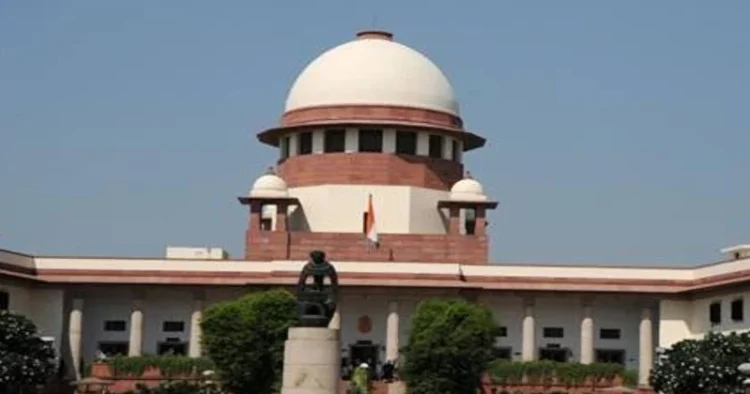The Supreme Court has held that a condition imposed by the Government that the land owner should handover a part of land free of cost for public utility purposes in return of the permission granted for converting the nature of the use of the land cannot be held illegal.
The Apex court remark came while setting aside a Bombay High Court judgement.
“It can be noticed that this Court in the case of Narayanrao Jagobaji Gowande Public Trust vs State of Maharashtra and others7 has held that if a Government gives the benefit of development of land concerned with permission to sub-divide the same and uses it for commercial purpose and it, in turn, requires the landowner to handover part of land free of cost for public utility purpose, such a clause cannot be held to be illegal. As such, we find that the High Court has grossly erred in allowing the writ petitions,” the top court said citing its earlier judgement.
“We, therefore, allow the appeals and quash and set aside the impugned common judgment and order dated 4th July 2019 passed by the High Court. The writ petition filed by the plot holders also shall stand dismissed,” a bench of justices BR Gavai and SVN Bhatti said in its September 22 order.
The top court was hearing a set of appeals challenging the common judgment and order passed by the Division Bench of the High Court of Bombay at Aurangabad, dated July 4, 2019. The appellant in both appeals was Shirdi Nagar Panchayat.
On December 15, 1992, a Development Plan for the Municipal Council was approved. Therein the disputed property was shown as a “Green Zone”/“No Development Zone”.
On September 30, 2000, a proposal regarding the conversion of land from a ‘No Development Zone’ to a ‘Residential Zone’ including the disputed property was published and objections
were invited.
On August 18, 2004, the Government issued a notification converting some land from a ‘No Development Zone’ to a ‘Residential Zone’, subject to the Municipal Council receiving 10 per cent compulsory ‘open space’ and 10 per cent as ‘amenity space’ free of charge. Apart from this, the area for the road was also to be transferred.
Thereafter, the landowners sought permission from the Town Planning Authority for the development of the plot, and the same was granted. On March 27, 2006, the landowners executed an agreement with the Municipal Council, thereby assigning and giving possession of some land as ‘open space’, as ‘amenity space’, and some portion as ‘internal road’ area to the Municipal Council out of the total land.
In 2012, when the Municipal Council sought possession of the property, the landowners filed a civil suit seeking perpetual injunction along with an application seeking a temporary injunction against the Municipal Council. The application seeking a temporary injunction was rejected by the trial court. Later the owner challenged it in High Court but withdrew it.
After the withdrawal of the writ petition before the High Court, the landowners later filed the suit before the High Court challenging the Government Notification dated August 18, 2004.
Vide the impugned common judgment and order dated 4th July 2019, the High Court held that the writ petition filed by the landowners was not maintainable. However, it partly allowed the writ petition filed by the plot holders. It quashed and set aside some conditions in the Government Notification dated 18th August 2004 in respect to ‘open space’ and ‘amenity space’.
HC further restricted the Municipal Council from changing the user of the land of ‘open space’ and ‘amenity space’ except for the beneficial enjoyment of residential plot holders. It further quashed and set aside the resolution dated 23rd January 2018 of the Municipal Council to the extent it resolved to construct an indoor game hall, multi-purpose meeting hall, and swimming pool on open space/amenity space.
“Insofar as the plot holders are concerned, they also did not stand on a better footing. They had purchased the plot knowing very well that in the sanctioned layout, 10 per cent of space was to be reserved as ‘open space’ and 10 per cent of the land was to be handed over to the Municipal Council as ‘amenity space,” the top court said.
“They were very well aware that 10 per cent of the land would be transferred to the Municipal Council by the landowners free of cost and that the land would vest in the Municipal Council. Knowing this fully well, they entered into transactions with the landowners,” the court said.
“As such, the writ petition at their behest also challenging the Notification after a period of almost 14 years ought to have been dismissed on the grounds of delay and laches. No doubt that the High Court was justified in holding that the ownership of the ‘open space’ would vest in the owners of the plot in view of the relevant DCR. The High Court was also right in holding that insofar as ‘open space’ is concerned, it was required to be kept as ‘open space’ for use by the plot holders,” the court said.
“However, insofar as the ‘amenity space’ is concerned, the High Court mixed it with the ‘open space’. It was to be handed over to the Municipal Council as one of the pre-conditions for converting the land from a ‘No Development Zone’ to a ‘Residential Zone’. Not only that but acting on the said notification, the landowners entered into more than one agreement with the Municipal Council, thereby agreeing to hand over the ‘open space’ as well as the ‘amenity space’ to the Municipal Council,” the court said.
(with inputs from ANI)




















Comments